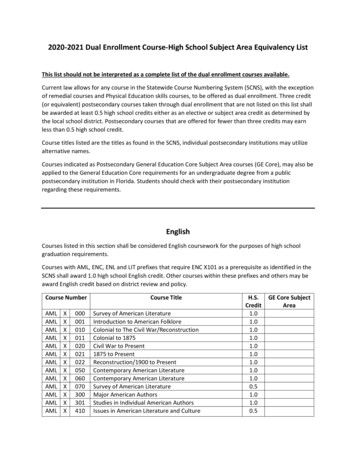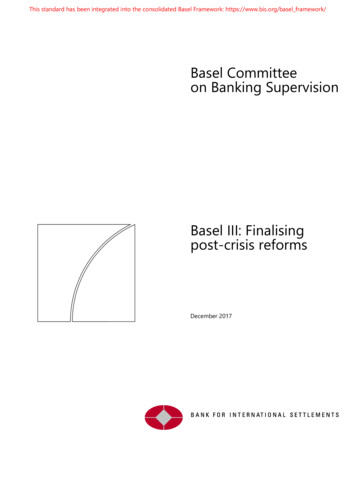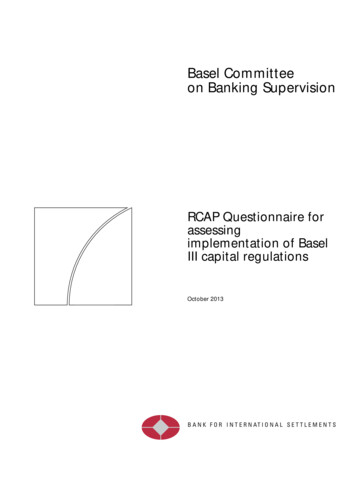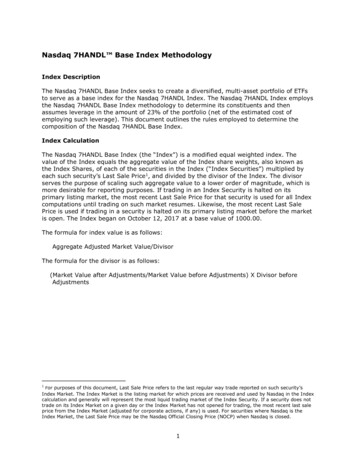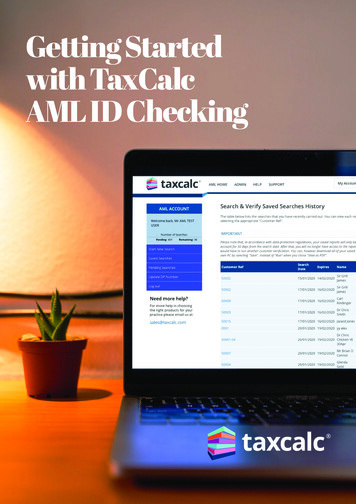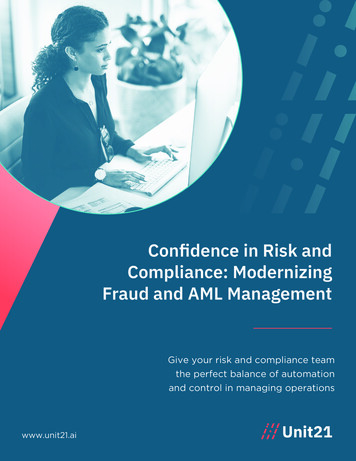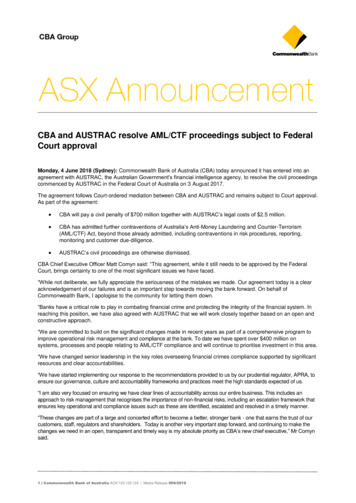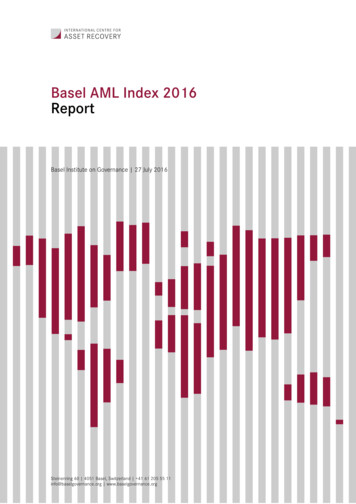
Transcription
Basel AML Index 2016ReportBasel Institute on Governance 27 July 2016Steinenring 60 4051 Basel, Switzerland 41 61 205 55 11info@baselgovernance.org www.baselgovernance.org
BASEL INSTITUTE ON GOVERNANCETable of contents1 Introduction12 What does the Basel AML Index measure?23 Basel AML Index 2016 Scores and Rankings34 Results & Findings44.1 High risk countries4.2 Low risk countries4.3 Largest improvements and deteriorations4.4 Regional results4.5 Notes on the findings5 Methodology5.1 Methodological approach5.2 How is the overall score calculated?5.3 Selection of data5.4 Scaling5.5 Weighting/Aggregation5.6 Missing data / imputation of missing data5.7 Data validation6 Annual Review 20156.1 General methodological approach and selection of indicators6.2 Update on the new FATF Mutual Evaluation Reports (4th Round) incorporating theeffectiveness rating6.3 Indicators for beneficial ownership information of trusts and companies6.4 Risk levels6.5 Discussion on final ranking scores and plausibility check7 Expert Edition7.1 Why use the Expert Edition?8 About the Basel Institute on Governance9 Annex 1Overview of risk indicators including 1
BASEL INSTITUTE ON GOVERNANCE1 IntroductionThis report is issued on the occasion of the launch of the fifth edition of the Basel Anti-MoneyLaundering (AML) Index which has been published by the Basel Institute on Governance (Basel Institute)since 2012. To date, the Basel AML Index remains the only index published by an independent not-forprofit organisation ranking countries according to their risk of money laundering and terrorist financing.The Basel AML Index is used by the private sector as an established AML country risk-rating tool forcompliance purposes, and in the public sector for research and policy measurement.The Basel AML Index 2016 edition covers 149 countries and provides risk ratings based on the qualityof a country’s framework for AML and countering terrorism financing (AML/CFT) and related factorssuch as perceived levels of corruption, financial sector standards and public transparency.The results of the Basel AML Index, which are presented in chapter 3, are derived from 14 indicatorsusing publicly available sources such as the FATF, Transparency International, the World Bank and theWorld Economic Forum. The scores are aggregated as a composite index using a qualitative and expertbased assessment. An analysis of the results of the 2016 edition of the Basel AML Index is presented inchapter 4.It is important to read these results chapters in conjunction with chapters 2 and 5, which provide adetailed account of the scope of what the AML Index can and cannot measure, and the methodologyused to calculate the overall score of the Basel AML Index. Without this background, results ofcomposite indices may easily be misunderstood or misrepresented, and this may have unwantedconsequences on any policy or compliance decision that is taken as a result of using the AML Index.The Basel Institute has conducted extensive research in calculating the final results following academicbest practices, and has its methodology reviewed and validated by an international and independentpanel of peer reviewers. The panel also checks that the rating is accurate, plausible and continues tocapture the latest development in the area of AML/CFT risks. A report from the 2015 peer reviewexercise is included in this report in chapter 6.The Basel AML Index is offered in two editions: The Public Edition offers the annual ranking of countriesaccording to their risk profiles and is available free of charge. The Expert Edition provides a morecomprehensive data set and allows for a selection of individual sub-indicator of the Index. The ExpertEdition is also periodically updated, covers some 50 countries more than the Public Edition, andincludes sanctions lists. With these additional features, it can serve as a sophisticated country riskassessment tool for regulatory purposes, particularly for compliance officers, and caters to users’diverse needs in relation to different compliance and regulatory requirements. The subscription-basedExpert Edition is also offered free of charge for public, academic and non-profit organisations;commercial enterprises are charged an annual fee starting at CHF 2000 depending on user intensity.Further details concerning the Expert Edition are described in chapter 7.The Basel Institute continues to actively facilitate the exchange of knowledge on the challenges ofAML/CFT risk rating. We therefore encourage comments and feedback on the Basel AML Index, as westrive to advance the use of AML country risk ratings for both research and compliance purposes.1
BASEL INSTITUTE ON GOVERNANCE2 What does the Basel AML Indexmeasure?The Basel AML Index measures the risk of money laundering and terrorist financing of countries basedon publicly available sources. A total of 14 indicators dealing with AML/CFT regulations, corruption,financial standards, political disclosure and rule of law are aggregated into one overall risk score. Bycombining these various data sources, the overall risk score represents a holistic assessmentaddressing structural as well as functional elements in the AML/CFT framework. As there are noreliable quantitative data on money laundering available, the Basel AML Index does not measure theactual existence of money laundering activity or amount of illicit financial money within a country but isdesigned to indicate the risk level, i.e. the vulnerabilities of money laundering and terrorist financingwithin a country.The Basel AML Index ranks countries based on the overall score and provides data that is useful forcomparative purposes. However, it should be stressed that the primary objective is not to rankcountries in comparison to each other. Rather, the Basel AML Index seeks to provide an overall pictureof a country’s risk level and to serve as a solid starting point for examining progress over time.2
BASEL INSTITUTE ON GOVERNANCE3 Basel AML Index 2016 Scores andRankings3
BASEL INSTITUTE ON GOVERNANCE4 Results & Findings4.1 High risk countriesThe 10 highest risk countries in the 2016 Basel AML Index are Iran, Afghanistan, Tajikistan, GuineaBissau, Cambodia, Mozambique, Mali, Sudan, Uganda and Myanmar. Although overall this list haschanged very little from the previous edition, it is noteworthy that Guinea-Bissau and Mali have seensome improvement in their scores. The majority of the higher risk countries however, have only slightlychanged their risk rating, indicating slow progress and difficulties in conducting structural changes thatcould improve their AML/CFT framework.Low-income and sub-Saharan countries have a proportionallyhigh presence in the top third of the highest risk countries ofthe Basel AML Index. The data shows that these countrieswere assessed as having weak AML/CFT systems combinedwith structural and functional vulnerabilities such as highrates of perceived corruption, weak judicial systems andinadequate financial sector standards. It is important howeverto note that the fact that these countries are placed higher inthe risk-rating category does not necessarily mean that theycan automatically be considered as attractive destinations formoney launderers. It only means that the country has aheightened vulnerability to money laundering due toshortcomings in their AML systems as assessed byinternational standards. More on this is explained in themethodology .89Mozambique7.89Mali7.86Sudan7.85Myanmar7.71Table 1 – Top 10 High risk countriesWhile it is the overall deficiencies in a country’s AML/CFT framework that weigh most heavily on theresult, the final score is made up of a combination of factors, including structural deficiencies notedabove, as well as the size of a country’s financial centre or its potential attractiveness as destinationcountry for illicit financial flows. See figure 1 for an illustration of this.What leads to high risk in the Basel AML Index?SHORTFALLS IN THEAML/CFT FRAMEWORKPOOR FINANCIALSTANDARDS ANDTRANSPARENCYHIGH LEVEL OFPERCEIVEDCORRUPTIONLACK OF PUBLICTRANSPARENCYHIGHRISKWEAK POLITICAL RIGHTSAND RULE OF LAWFigure 1 - What leads to high risk in the Basel AML Index?4
BASEL INSTITUTE ON GOVERNANCE4.2 Low risk countriesFinland remains the lowest risk country in the Basel AML Indexbut Estonia lost its ranking as the second lowest risk countrydue to a significantly worsened score, up from 3.19 in 2015 to3.82 this year. Lithuania has taken Estonia’s place as secondlowest risk country in the 2016 ranking. Among the low riskcountries, Slovenia has also seen its score worsen significantly,from 3.41 last year to 4.06 in 2016.CountryOverall ScoreFinland3.05Lithuania3.62Table 2 - Low risk countriesMost countries grouped near the lower risk category can demonstrate a strong AML/CFT compliancelevel. Additionally, they portray high public and financial transparency and low levels of corruption.Some of these countries are also positively influenced in comparison to other countries because theyare not considered a significant financial centre and play a smaller role in the global economy.For a majority of countries with lower risk ratings, their positive ranking derives importantly from theFATF Mutual Evaluation Report (MER). However, this and last year’s Basel AML Index show that therevised FATF methodology, which focuses on the effective implementation of countries’ AML/CTFframework, tends to result in less favourable rating in a number of countries, because the actualimplementation of laws seems to lag behind technical compliance. Belgium and Italy for example,despite improving their legal frameworks, received due to the evaluation of its effectiveness a worseoverall assessment compared to their previous assessments. It can be expected that the scores ofsome of the lower risk countries might worsen in the coming years as the revised FATF methodology isapplied in more countries. At this point, however, the majority of countries are still rated according tothe old FATF methodology only.14.3 Largest improvements and deteriorationsTop 10 improvers 2016CountryOverall Score 2016Overall Score 2015Change in score2015-2016Kuwait5.546.25 -0.71Ecuador5.486.05 -0.57Seychelles6.006.53 -0.53Albania5.045.56 -0.52Bosnia-Herzegovina5.185.64 -0.46Austria5.025.45 -0.43Costa Rica *5.936.34 -0.41Greece5.535.83 -0.30Korea, South4.925.2 -0.28Armenia *4.634.89 -0.26* : Overall score based on a new FATF evaluation, which includes an effectiveness assessment.Kuwait has addressed a number of key deficiencies pertaining to the FATF recommendations asattested by the FATF-Follow up report, which lead to the greatest improvement from the previous 20151See chapter 6.2 for more details on the use of the new FATF MERs in the calculation of the Basel AML Index.5
BASEL INSTITUTE ON GOVERNANCEedition.2 The FATF the report also noted however that there is insufficient information to assess theeffectiveness of the AML/CFT system, which will be evaluated in the next assessment cycle of theFATF.Ecuador saw strong gains in the Public Transparency and Rule of Law indicators and Seychellesperformed better in the Financial Secrecy Index (FSI) enabling it to lower its risk rating in the Basel AMLIndex. Albania, Armenia, Bosnia, and Costa Rica also improved due to recent re-evaluation of theirAML/CFT legal framework under the FATF assessments, which rated their compliance levels morepositively.Austria’s positive change was driven by improvements in the political finance indicator illustrating moretransparency in relation to the financing of political parties and candidates; however Austria has alsoundergone an evaluation under the new FATF evaluation methodology, expected to be published inAugust 2016, which may change their rating again.Greece and Korea improved as a result of the latest release from the FSI. Korea additionally improved infinancial standards and public transparency.Top 10 losers 2016CountryOverall Score2016Overall Score2015Change in score2015 - 2016Vanuatu *7.016.19 0.82Chile4.804.02 0.78Sri Lanka *7.166.44 0.72Slovenia4.063.41 0.65China6.706.05 0.65Estonia3.823.19 0.63Serbia *5.825.2 0.62Turkey6.555.93 0.62Finland3.052.53 0.52Macedonia4.984.5 0.48* : Overall score based on a new FATF evaluation, which includes an effectiveness assessment.Serbia, Sri Lanka and Vanuatu recorded a higher risk rating this year due to the new assessmentmethodology adopted by the FATF, which also assessed the effectiveness of their AML/CFT frameworkas mentioned above. The rankings of China, Estonia, Finland, Macedonia and Turkey deterioratedsimply due to the fact that they were all included in the FSI for the first time and thus assessedaccording to their financial secrecy standards and their roles as financial centres. Chile’s increase of itsrisk score was a combination of being included in the FSI and an increase in the perception ofcorruption from Transparency International (TI).2MENAFATF Follow up Report on Kuwait, 2015: http://www.menafatf.org/MER/Kuwait Exit FUR ENG.pdf (last accessed in June2016)6
BASEL INSTITUTE ON GOVERNANCETop10 higher risk countries among OECDEU CountriesCountryOverall ScoreCountryOverall 53Greece5.53Italy *5.36Switzerland5.46Germany5.33Italy *5.36Cyprus5.12Germany5.33France5.03United n ited Kingdom4.77Czech Republic4.66Belgium .05* : Overall score based on a new FATF evaluation, which includes aneffectiveness assessment.Finland* : Overall score based on a new FATF evaluation, whichincludes an effectiveness assessment.7
BASEL INSTITUTE ON GOVERNANCE4.4 Regional resultsTop 14 higher risk in Europe & Central AsiaLatin America & the CaribbeanCountryOverall ScoreCountryOverall an6.21Argentina6.74Luxembourg5.89Dominican Republic6.74Kazakhstan5.88Venezuela6.53Serbia Honduras6.04Italy *5.36Guatemala5.97Germany5.33Costa Rica *5.93Moldova5.24Trinidad And Tobago St. Vincent And The Grenadines5.59Ecuador5.48Grenada5.18St. Lucia5.17* : Overall score based on a new FATF evaluation, which includes aneffectiveness assessment.Middle East & North AfricaUruguay5.15CountryOverall ScoreChile4.80Iran8.61El ca4.40Algeria6.50Peru4.31United Arab t5.54Saudi nisia4.62Malta4.49* : Overall score based on a new FATF evaluation, which includes aneffectiveness assessment.8
BASEL INSTITUTE ON GOVERNANCEEast Asia & PacificSub-Saharan AfricaCountryOverall ScoreCountryOverall ScoreCambodia7.89Uganda e7.89Vanuatu *7.01Mali7.86China6.70Sudan7.85Marshall .52Liberia7.41Philippines6.31Sao Tome And otho7.24Papua New Guinea6.11Burkina Faso7.21Timor-Leste (East Timor)5.87Sierra Leone7.12Japan5.76Ethiopia *7.09Hong Kong Sar, China5.51Tanzania7.08Malaysia *5.46Niger6.98Taiwan, China5.12Zimbabwe6.98Australia *4.99Nigeria6.97Korea, South4.92Mauritania6.82Singapore4.91Cape Verde6.74New Zealand3.86Angola6.71* : Overall score based on a new FATF evaluation, which includes aneffectiveness assessment.Rwanda6.70Gambia6.67South AsiaNamibia6.64Benin6.52Cote ritius5.82Malawi5.76Senegal5.37South Africa4.86CountryOverall ScoreAfghanistan8.51Nepal7.57Sri Lanka *7.16Pakistan6.62Bangladesh6.40India5.69* : Overall score based on a new FATF evaluation, which includes an* : Overall score based on a new FATF evaluation, which includes aneffectiveness assessment.effectiveness assessment.9
BASEL INSTITUTE ON GOVERNANCE4.5 Notes on the findingsThe Basel AML Index scores provide an overall picture of a country’s risk level and serve as a solidstarting point for examining changes over time. While the Basel AML Index scores summarize a complexand multidimensional issue, they should not be viewed as an actual quantitative measurement of moneylaundering and terrorist financing activity, nor should they be taken as a specific policyrecommendation for countries or institutions. For a detailed country diagnostic, the Basel AML Indexshould be complemented by a more fine-grained country profile study. Researchers, policy-makers andcompliance officers who are interested in better understanding a country’s risk rating/result areencouraged to consult the specific sub-indicators employed in the compilation of the Basel AML Index.The sub-indicators provide for each country a score that might be more relevant to a specific riskassessment such as for different client segments. A detailed view on the sub-indicators can beaccessed via the Expert Edition. For more information on the Expert Edition see chapter 7.10
BASEL INSTITUTE ON GOVERNANCE5 Methodology5.1 Methodological approachThe objective of the Basel AML Index is to provide a risk rating and not to measure money launderingitself as there is no reliable data to assess this, but to provide ranking countries according to their riskof money laundering and terrorist financing. This presents several methodological challenges. To datethere has been no universally agreed definition or methodological approach that prescribes whether aparticular country represents a high risk. Experts and regulatory institutions may have differentrequirements on the best method of assessing a country’s risk. To address these challenges the BaselInstitute conducted extensive research and created a conceptual framework to be considered forassessing money laundering and terrorist financing risk. In developing the Basel AML Index, a simplifiedapproach, as prescribed in the best practices of creating a composite indicator3, has been used.Figure 2 provides an overview of the steps that are being conducted to develop the Basel AML Indexoverall score.Methodological overviewIndependentresearch Creating aconceptualframeworkData selectionWeighting Based onresearch andexpertassessment Based onresearch andexpertassessmentData validation Annualreview byexternalexperts Statisticalanalysis Figure 2 - Methodological overviewIn sum, the development and conceptual framework of the Basel AML Index model is characterised by: 3A scientific approach in its creation (using the OECD composite index guidelines)Research and expert based selection of indicatorsA transparent annual review testing and validating its methodology and results with externalexperts from the AML torsmethodologyanduserguide.htm (as of 18 July 2016).11
BASEL INSTITUTE ON GOVERNANCE5.2 How is the overall score calculated?The Basel AML Index is a composite index. This entails that the overall score is a weighted average of14 indicators. The Basel Institute does not generate its own data but relies on data from various publiclyavailable sources such as the FATF, Transparency International, the World Bank and the WorldEconomic Forum. The indicators are grouped into five categories, based on the selected indicators andthe conceptual framework to capture the multidimensionality of data (see figure 2).FATF Recommendations (30%)Money Laundering /Terrorist FinancingRisk (65%)TJN- Finance Secrecy Index (25%)US INCSR – Volume II on Money Laundering (10%)OverallScoreCorruption Risk (10%)FinancialTransparency &Standards (15%)Public Transparency& Accountability (5%)TI CPI – Perception of Public Corruption (10%)WB Doing Business – Business Disclosure (1.88%)WEF GCR – Strength of auditing & reporting (5.63%)WEF GCR – Regulation of securities (5.63%)WB IDA IRAI – Financial Sector (1.88%)Int. Idea – Political Finance Database (1.67%)IBP – Open Budget Index (1.67%)WB IDA IRAI – Transparency, Account & Corr. (1.67%)FH – Press Freedom & Freedom in the World (1.67%)Political Risk (5%)WEF GCR – Institutional Strength (1.67%)WJP – Rule of Law (1.67%)Figure 3 - Basel AML Index Overall Score (percentages rounded to two decimal digits)5.3 Selection of dataThe Basel AML Index attempts to capture the whole scope of money laundering and terrorist financingrisk and therefore applies a holistic approach in selecting the relevant risk indicators. Although, there isno universally accepted list of indicators in assessing a country’s money laundering and terroristfinancing risk, some guidance exists on what to look out for. A key consideration is whether ajurisdiction has an adequate AML/CFT framework in place. An increasing focus is on the effectivenessof the implementation of such a framework as addressed in the revised FATF methodology. Otherfactors include the level of corruption and rule of law. Additional factors such as financial and publictransparency as well as a country’s global role in the financial system should be considered to assessthe whole picture. The criteria for the selection and inclusion of indicators are: Relevance and relationship to risks of money laundering and terrorist financing (related surveyquestions or assessment of relevant financial standards and regulations)Methodology of sources12
BASEL INSTITUTE ON GOVERNANCE Availability of recent data (maximum age of data is 3 years with the exception of FATF MutualEvaluation Reports)Country coveragePublic availabilityLow overlap with other indicatorsAnnex 1 contains a table of sources including their individual weightings.5.4 ScalingMost indicators chosen for the Basel AML Index have their own scoring system. The individual sources(raw data) are rescaled to run from 0 – 10 where 0 indicates the lowest risk level and 10 the highestrisk level. In order to reach a unified coding system all raw data or individual indicator scores werecollected and rescaled using the Min-Max method into a 0 – 10 system. Only after rescaling the data isthe indicator then applied in our composite index.5.5 Weighting/AggregationIn creating a composite index, each indicator or component receives a weight to aggregate all scoresinto one overall score. A standard and comparatively simple system would consist of adding allindicators and weighting them equally.4 This assumes however that all indicators are equally relevant inthe context of money laundering and terrorist financing. The Basel AML Index though resorts to adiverse set of indicators, each of them measuring a different issue. Consequently, certain indicators aremore important than others in assessing money laundering and terrorism financing risk. The BaselInstitute has been applying its own weighting scheme in order to reflect an appropriate overall score.These individual weightings were agreed upon by senior anti-money laundering experts from the BaselInstitute and the International Centre for Asset Recovery (ICAR) and are annually reviewed byindependent external experts.5 The Basel AML Index team is also in contact with regulatory andsupervisory institutions that are subscribed to the Expert Edition to discuss the weighting scheme.During our review and feedback phase no major criticism was received to change the current weightingmethodology.45Another method would be through statistical models, such as factor analysis and data development analysis. Weights are in thiscase chosen to reflect the statistical quality of the data. Statistically more reliable data with broad coverage are assigned with moreweighting. The OECD Handbook on Composite Indicators states however that “this method could be biased towards the readilyavailable indicators, penalising the information that is statistically more problematic to identify and measure” OECD Handbook /42/42495745.pdfThis approach is also known as expert weighting scheme or so-called participatory method, where experts rank or categorize eachof the identified indicators in terms of their degree and relative importance. For example, the FATF Mutual Evaluation Reports whichdeal specifically with the topic of AML/CFT have been weighted stronger than, for example, indicators reflecting the civil rights orpolitical risk indices, which should be also factored in but in a less representative way.13
BASEL INSTITUTE ON GOVERNANCEPublic Transparency &Accountability5%Political & Legal Risk5%Financial Transparency& Standards15%Corruption Risk10%Money laundering /Terrorist Financing Risk65%Figure 4 - Weighting scheme5.6 Missing data / imputation of missing dataThere is not always a complete set of 14 indicators available for all countries. Therefore, a country’soverall score is calculated based on available data only, and missing values are not replaced. In thePublic Edition of the 2016 Basel AML Index, only countries for which data is available for a minimum of8 out of 14 indicators are included in the ranking. Countries for which data is missing in relation to allthree indicators in the key category (ML/TF Risk) were excluded as well, regardless of whether in totaldata on 8 or more indicators was available for them.6 Applying these criteria, the 2016 version of thePublic Edition of the Basel AML Index features 149 countries. By contrast, in the Expert Edition 203countries are included, due to the inclusion of countries with less than eight indicators. These arespecifically marked and indicated in the Expert Edition.5.7 Data validationAs a final step, data is validated and cross-checked against a qualitative expert assessment and throughan annual review. Each year a review meeting is conducted to assess the methodology anew andensure that the country risk rating is being tested independently. The annual review meeting processentails verifying the quality of data/indicators and provides an additional layer of analysis to identifypossible mistakes or inconsistencies within the ranking. The results of the annual review are publishedeach year in the annual Basel AML Index report (see chapter 6 below), which allows for public scrutinyand verification by external experts, researchers and academics.6Due to our own weighting methodology the impact of certain missing indicator such as the ones within the ML/TF risk categories ishigher than in other categories.14
BASEL INSTITUTE ON GOVERNANCEThe 2014 annual review also included an internal statistical analysis to test the model, using forexample a correlation analysis and testing the weighting scheme and comparing it with alternativeweighting schemes. A summary can be read in the Basel AML Index Report 2014.6 Annual Review 2015In order to provide a reliable risk ranking on AML/CFT, a regular quality check of the methodology andselection of indicators is for the Basel AML Index is essential. The Basel AML Index team assesses andtests the methodology and its country risk model outputs through a comprehensive annual reviewprocess based on external independent expert review.Each year, the Basel AML Index team invites external experts from various backgrounds including thefinancial industry, law enforcement and dedicated international and non-profit organisations toparticipate in the annual review meeting to review the current Basel AML Index methodology and toprovide feedback in order to ensure a transparent and participatory approach in calculating andvalidating the Basel AML Index.The 2016 annual review meetings were held in Basel in the form of conference calls between 06 Juneand 13 June 2016. The talking points of the annual review meetings and any additional feedbackreceived via emails as well as the decisions made based on these meetings, are summarised below.6.1 General methodological approach and selection of indicatorsDuring the annual review meetings, the Basel Institute provided a short overview of the methodologicalapproach, stressing that the foundation for the development of the Basel AML Index lies in scientificresearch and its application for practical purposes as a compliance tool in conducting country riskassessments. Participants were asked to provide feedback on the methodology or share their views onit.On the methodology and selection of indicators of the Basel AML Index, participants raised the issue ofterrorism financing, which has garnered increased focus within the AML community, most notably atthe FATF. Participants pointed out that money laundering and terrorism risk are two different aspectsbut combined within the same category in the Basel AML Index. While combining money laundering andterrorism financing risk as one category is not an issue, participants asked whether it would possible toidentify which of the indicators within this category specifically cover terrorism financing.In response to this, the Basel Institute referred to the use of the FATF Mutual Evaluation as the keyindicator, which covers in their recommendation five to eight the elements of terrorism financing. TheFATF scores provide an assessment of both the AML framework as well as the terrorism financingframework of each country. Due to the FATF scores being an aggregate of the forty recommendations,participants further inquired if it is possible to single out the individual recommendations assessingterrorism financing only. The Basel Institute proposed, if requested on an individual basis, to share theraw d
The 10 highest risk countries in the 2016 Basel AML Index are Iran, Afghanistan, Tajikistan, Guinea-Bissau, Cambodia, Mozambique, Mali, Sudan, Uganda and Myanmar. Although overall this list has changed very little from the previous edition, it is noteworthy that Guinea-Bissau and Mali have seen some improvement in their scores. .

